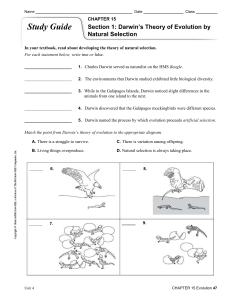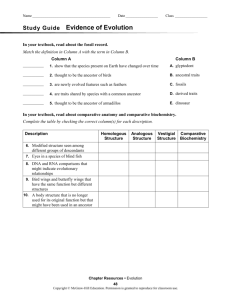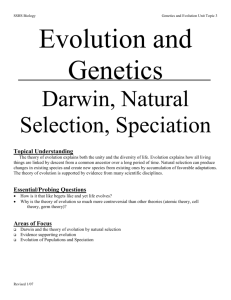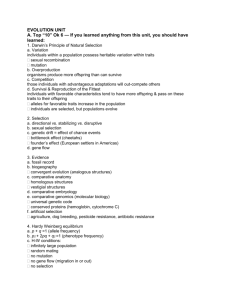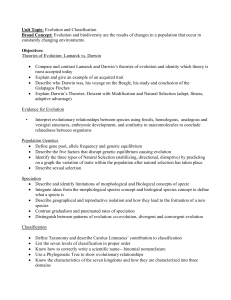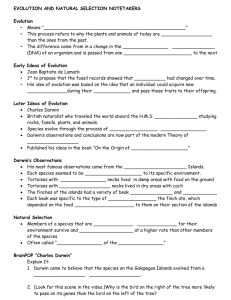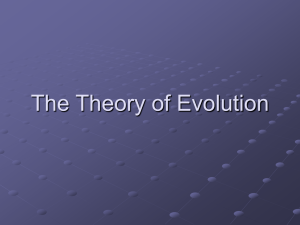Name - Images
advertisement
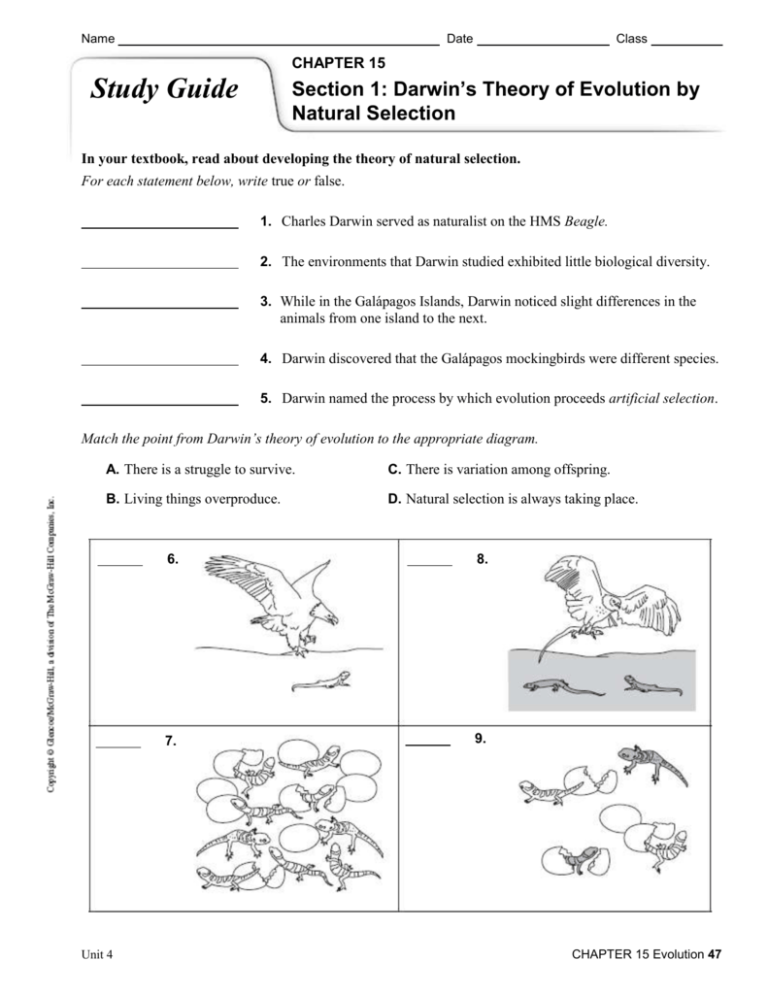
Name Date Class CHAPTER 15 Section 1: Darwin’s Theory of Evolution by Natural Selection Study Guide In your textbook, read about developing the theory of natural selection. For each statement below, write true or false. 1. Charles Darwin served as naturalist on the HMS Beagle. 2. The environments that Darwin studied exhibited little biological diversity. 3. While in the Galápagos Islands, Darwin noticed slight differences in the animals from one island to the next. 4. Darwin discovered that the Galápagos mockingbirds were different species. 5. Darwin named the process by which evolution proceeds artificial selection. Match the point from Darwin’s theory of evolution to the appropriate diagram. A. There is a struggle to survive. C. There is variation among offspring. B. Living things overproduce. D. Natural selection is always taking place. Unit 4 6. 8. 7. 9. CHAPTER 15 Evolution 47 Name Date Class CHAPTER 15 Study Guide Section 2: Evidence of Evolution In your textbook, read about the fossil record. Match the description in Column A with the term in Column B. Column A Column B 1. show that the species present on Earth have changed over time A. glyptodont 2. thought to be the ancestor of birds B. ancestral traits 3. are newly evolved features such as feathers C. fossils 4. are traits shared by species with a common ancestor D. derived traits 5. thought to be the ancestor of armadillos E. dinosaur In your textbook, read about comparative anatomy and comparative biochemistry. Complete the table by checking the correct column(s) for each description. Description Homologous Structure Analogous Structure Vestigial Structure Comparative Biochemistry 6. Modified structure seen among different groups of descendants 7. Eyes in a species of blind fish 8. DNA and RNA comparisons that might indicate evolutionary relationships 9. Bird wings and butterfly wings that have the same function but different structures 10. A body structure that is no longer used for its original function but that might have been used in an ancestor 48 Evolution CHAPTER 15 Unit 4 Study Guide, Section 2: Evidence of Evolution continued In your textbook, read about geographic distribution and types of adaptation. If the statement is true, write true. If the statement is false, replace the italicized term or phrase to make it true. 11. Evolutionary theory predicts that species respond to similar environments in similar ways. 12. Geographic distribution is the study of the distribution of plants and animals on Earth. 13. Similar environments can lead to the evolution of similar animals, even if they are not close relatives. 14. Traits that enable individuals to survive or reproduce better than individuals without those traits are called reproduction. 15. Mimicry involves a harmless species that has evolved to closely resemble a beneficial one. 16. The type of morphological adaptation shown in the picture above is camouflage. 17. Mimicry and camouflage are morphological adaptations that increase a species’ fitness. 18. Antibiotic resistance is a form of adaptation that causes some diseases to come back in more harmful forms. Unit 4 CHAPTER 15 Evolution 49 Name Date Class CHAPTER 15 Study Guide Section 3: Shaping Evolutionary Theory In your textbook, read about the mechanisms of evolution, speciation, and patterns of evolution. Write the term or phrase that best completes each statement. Use these choices: adaptive radiation allopatric speciation directional selection disruptive selection founder effect genetic drift gradualism sexual selection stabilizing selection sympatric speciation 1. is a change in allelic frequencies in a population that is due to chance. 2. removes individuals with average trait values, creating two populations with extreme traits. 3. The most common form of selection, , removes organisms with extreme expressions of a trait. 4. When a small sample of the main population settles in a location separated from the main population, the 5. In can occur. , a species evolves into a new species without any barriers that separate the populations. 6. will shift populations toward a beneficial but extreme trait value. 7. In , a population is divided by a barrier, each population evolves separately, and eventually the two populations cannot successfully interbreed. 8. is a change in the size or frequency of a trait based on competition for mates. 9. One species will sometimes diversify in a relatively short time into a number of different species in a pattern called . 10. The idea that evolution occurred in small steps over millions of years in a speciation model is currently known as . Refer to the figure. Respond to each statement. 11. Specify which moth would survive if pollution increases. 12. State the name of the phenomenon illustrated. 50 Evolution CHAPTER 15 Unit 4
